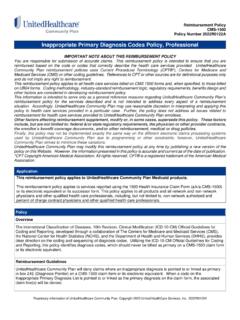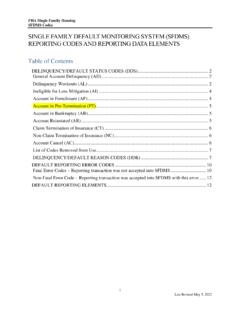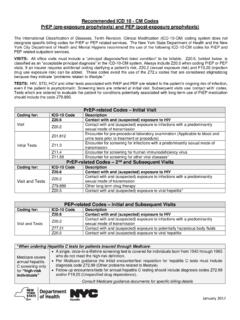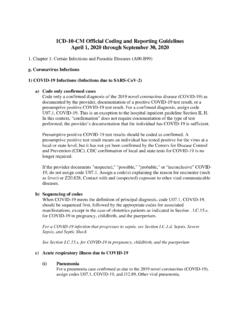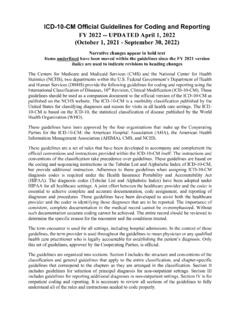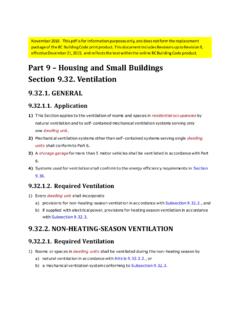Transcription of Healthcare Common Procedure Coding System Level II …
1 DEP ART MENT OF HEALT H & HUMAN SERVICES Centers for Medicare & Medicaid Services 7500 Security Boulevard, Mail Stop C5-09-14 Baltimore, Maryland 21244-1850 Healthcare Common Procedure Coding System (HCPCS) Level II Coding procedures This information provides a description of the procedures the Centers for Medicare & Medicaid Services (CMS) follows in processing HCP CS code applications and making Coding decisions. FOR FURTHER INFORMATION CONTACT: P lease submit an inquiry to the HCP CS mailbox at HCP A. HCPCS BACKGROUND INFORMATION Each year in the United States ( ), health care insurers process over f ive billio n c la ims f or payment. For Medicare and other health insurance programs to ensure that these claims are processed in an orderly and consistent manner, standardized Coding systems are essential.
2 The HCP CS Level II code Set is one of the standard, national medical code sets specified by the Health Insurance P ortability and Accountability Act (HIP AA) for this purpose. The HCP CS is divided into two principal subsystems, referred to as Level I and Level II of the HCP CS. Level I of the HCP CS is comprised of Current P rocedural Terminology (CPT), a numeric Coding System maintained by the American Medical Association (AMA). The CP T is a uniform Coding System consisting of descriptive terms and codes that are used primarily to identify medical services and procedures furnished by physicians and other health care professionals. These health care professionals use the CP T to identify services and procedures for which they bill public or private health insurance programs.
3 The CP T codes are republished and updated annually by the AMA. HCP CS Level II is a standardized Coding System that is used primarily to identify drugs, biologicals and non-drug and non-biolo g ic a l ite ms, supplies, and services not included in the CPT code set jurisdiction, such as ambulance services and durable medical equipment, prosthetics, orthotics, and supplies (DMEP OS) when used outside a physician's office. Because Medicare and other insurers cover a variety of services, supplies, and equipment that are not identified by CP T codes, the HCP CS Level II codes were established for submitting claims for these items. HCPCS Level II codes are also referred to as alpha-numeric codes because they consist of a single alphabetical letter followed by four numeric digits, while CP T codes primarily are identified using five numeric digits.
4 A. HISTORY The development and use of Level II of the HCP CS began in the 1980s. Concurrent to the use of Level II codes, there were also Level III codes. HCPCS Level III were developed and used by Medicaid State agencies, Medicare contractors, and private insurers in their specific programs or local areas of jurisdict ion. For purposes of Medicare, Level III codes were also Page 2 of 12 referred to as local codes. Local codes were established when an insurer preferred that suppliers use a local code to identify a service, for which there is no Level I or Level II code , rather than use a "miscellaneous or not otherwise classified code ." HIP AA required the Secretary to adopt standards for Coding systems that are used for reporting health care transactions.
5 Thus, regulations were published in the Federal Register on August 17, 2000 (65 FR 50312), to implement standardized Coding systems under HIP AA. These regulations provided for the eliminat ion of Level III local codes by October 2002, at which time, the Level I and Level II code sets could be used. The elimination of local codes was postponed, as a result of section 532(a) of BIP A, which continued the use of local codes through December 31, 2003. The regulation that was published on August 17, 2000 (45 CFR ), to implement the HIP AA requirement for standardized Coding systems established the HCP CS Level II codes as the standardized Coding System for describing and identifying health care equipment and supplies in health care transactions that are not within the CP T code set jurisdiction.
6 The HCP CS Level II Coding System was selected as the standardized Coding System because of its wide acceptance among both public and private insurers. B. AUTHORITY The Secretary of the Department of Health and Human Services has delegated authority under the Health Insurance P ortability and Accountability Act of 1996 (HIP AA) to the AMA and CMS to maintain and distribute HCP CS Level I and Level II codes, respectively. C. HCPCS Level II CODES The HCPCS Level II Coding System is a comprehensive, standardized System that c la s s if ie s s imila r products that are medical in nature into categories for the purpose of efficient claims processing. For each alpha-numeric HCP CS code , there is descriptive terminology that identifies a category of like items.
7 These codes are used primarily for billing purposes. For example, suppliers use HCP CS Level II codes to ide ntif y ite ms on c la im forms that are being bille d to a private or public health insurer. Currently, there are national HCP CS codes representing almost 8,000 separate categories of like items or services that encompass products from different manufacturers. When submitting claims, suppliers are required to use one of these codes to identify the items they are billin g. HCP CS is a System for identifying items and certain services. It is not a methodology or System for making coverage or payment determinations, and the existence of a code does not, of itself, determine coverage or non-coverage for an item or service.
8 While these codes are used for billing purposes, decisions regarding the addition, deletion, or revision of HCP CS codes are made independent of the process for making determinations regarding coverage and payment. With regard to the Medicare program, if specific Medicare coverage or payment indicators or values have not been established for any new HCP CS codes, this may be because a national Medicare coverage determination and/or fee schedule amounts have not yet been established for these items. This is neither an indicator of Medicare coverage or non-coverage. In these cases, until national Medicare coverage and payment guidelines have been established for these codes, the Medicare coverage and payment determinations for these items may be made based on the Page 3 of 12 discretion of the Medicare contractors processing claims for these items.
9 D. TYPES OF HCPCS Level II CODES There are several types of HCP CS Level II codes depending on the purpose for the codes and the entity with responsibilit y for establishing and maintaining them. HCPCS National code s National HCP CS Level II codes are maintained by CMS. CMS is responsible for making decisions about additions, revisions, and deletions to the national alpha-numeric codes. These codes are for the use of all private and public health insurers. There is a CMS HCP CS Workgroup, which is an internal workgroup comprised of federal government employees who represent the major components of CMS, as well as other pertinent Federal agencies, including the Department of Veterans Affairs and the Department of Defense.
10 HCPCS Level II applications are reviewed by the CMS HCP CS Workgroup at regularly scheduled meetings to determine whether Coding requests warrant a change to the national codes. This workgroup informs CMS decisions. The application and instructions for requesting that CMS add, revise, or discontinue a Level II code is detailed on CMS HCP CS Level II website at ml. CMS also may issue codes based on the needs of its programs or other federal programs, and those programs are not required to submit an application for a code to be issued. De ntal code s Dental codes, or D codes, are a separate category of national codes. The Current Dental Terminology (CDT) is published, copyrighted, and licensed by the American Dental Association (ADA).










